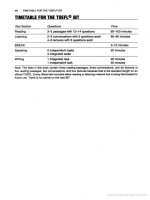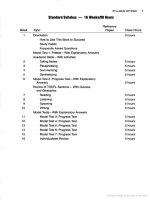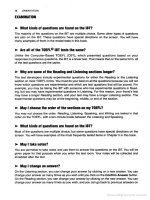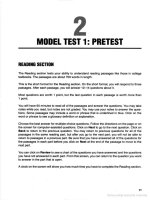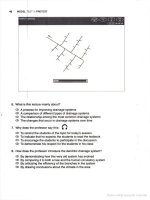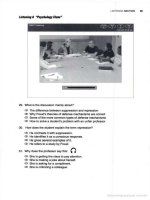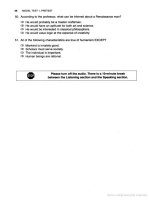Toefl ibt internet based test 2006 - 2007 part 11 ppsx
Bạn đang xem bản rút gọn của tài liệu. Xem và tải ngay bản đầy đủ của tài liệu tại đây (636.71 KB, 7 trang )
SPEAKING seCTION
53
"'''''.''''''
.I",o t/N
•
.,
,
.,.""k
,,
"
Now
fisten to part
of
a talk
in
a biology laboratory. The teachng assistant is explaining
how to use
the
microscope.
Question
Using the main points
and
examples from
the
talk,
desaibe
the two major systems
oflhe
lab-
oratory microscope, and then explain
how
to use it.
Preparation
TIITI9
: 20 seconds
Recording
lime
: 60 seconds
WRITING SECTION 65
()
Model Test 1,
Writing
Section, CD 2, Track 2
m.Fl·
""""
'.:';';-
;',;"
/,;;;;-,
. " " ,
-
~
(')
Now listen to 8 lecture on the same topic as the passage that you have
Jus
t read.
Question
Summarize the main points
in
the lecture, explaining how they cast doubt on the ideas
in
the
reading passage.
,."".IfI
••
t &ut"AI
,.,.".",
Lndw"
Question
Leaders like John
F.
Kennedy
and
Martin Luther King have made Important contributions
to the
people of the United States. Name
ano
ther
world
leader you think
Is
Important. Give
specifiC reasons lor your Choice.
•
This Is
the
end
of
Model
Te
st 1 •
To cheetl
your
enswers, refer
to
wExplenetory
or
Example
Anlwers
end
Audio
Scripts
for
Model Test
s:
Model Test 1
,"
Chapter 7, pages 552-585.
64
MOOEL
TEST
1:
PRETEST
WRITING
SECTION
The Writing section tests your
aMity
to
write essays in English similar to those that you would
write in college coursas.
During the test, you will write
two
essays. The integrated essay asks for your response to an
academic reading passage and a lecture on the same topic.
You
may
take notes
as
you read
and
listen, but notes are not graded.
You
may use your notes to write the essay. The lecture
will
be
spoken, but the directions and lhe questions will
be
written.
You
will have 20 minutes to
plan, write, and revise your response. Typically, a good essay
lor
the integrated topic will
require
that you write
150-22
5 words.
The independent
essay usually 'asks for your opinion about a familiar topic.
You
will have
30 minutes to plan, write, and revise your respoose. Typically, a good essay for the indepen-
dent topic will require that you write
300-350
words.
A
clock on the screen will show you how much time
you
have
to complete each essay.
You
have 20 minutes to plan, write, and revise your response to a reading passage and a lec-
ture on the same topic. First, read the passage and take notes. Then, listen to the lecture and
take notes.
Finally, write your response to the writing question. Typically, a
good
response will
requl
r
~
that you wrtle
150-22~
words.
Read i
ng
P
assage
Time: 3 minutes
Historically, schoots in the United States have borrowed the European sys-
tem of school organization, a system that separates students into grades by
chronological
age.
In
general, children begin lormal schooling at the age of
she
in what is referred to
as
the first grade. For the most part, students progress
through
twelve grades; however, some students who do not meet minimum
requirements for a particular grade
may
be
asked to repeat the year.
Graded schools are divided into primary gracles, intermediate grades, and
secondary grades. Primary
education includes grades 1 through 5 or 6, and
may
also provide kindergarten as a preparation for lirst grade. Referred
10
as
elementary
school, these grades are usually
taughJ:
by
one teacher in a sel/-
contained classroom. Intermediate grades begin with grade 6 or 7 and offer
three years of Instruction. At this level, teams of teachers may collaborate to
provide subject-based
classes similar to those offered in high school. Viewed
as a preparation for high school, I
nt
ermediate education
Is
known as junior high
school. At grade 9 or
to.
secondary school begins. Classes taught by subject
specialists
usually last about fifty minutes to allow a studem ten minutes
to
move to the next class before it begins at the lop of the hour. AI the end of
twelve successful grades of instruction, students are eligible !of a secondary
school diploma,
more commonly called a high school diploma.
~
•
••••
.
•
'cr<ale
ACADEMIC
SKILLS
TAKING
NOTES
Taking notes is writing down information while
you
are listening
or
reading. There are three
problems thai you
will
confront when you are laking nol
es
.
1.
The professor determines the pace
of
a lecture. This means
that
you have to
lake
notes as quickly
as
the
professor speaks.
2.
The
not
must
Include
all
the
main
idA.
and
major
facta
. This means that you
have to know
how
to
Identify
important information when you hear it
or
read
it
3. The
not
may
be
uMd
for
diffef'ent
reasons
. This means that you have to
organile
the
notes
10
help
you
remember
,
to
add
to
the
information
from
a
nothe
r
assignment
, or
lO
plan
a Sj: B
ech
or
an
essay.
Th
is
chapter
wi
ll
help
you
i
mprove
your
no
te taking
skills
.
You
wilileam
how
to
• Organize
your
notes
o identify Important Information
• Take
notes
quicldy
How
'111111
t/JeH
strateg_
help
you
on
the
TOEFL 1 By learning to take better notes
when
you
heal
lectures, you will have Ihe Infonnation you
need
to respond to
the
listening
comprehension
questions
and
to
prepare
your
speaking
and
writing
questions
.
You
will
even
improve your reading comprehension. Taking excellent notes is
one
of
the
most imponant aca-
demic skills for success on the TOEFL and after the TOEFL
when
yoo
are enrolled in a college
or
university
program.
ORGAlIZE
YOUR
IOTES
Sb
to
UIII
~ Anticipate the purpose
~ Divide the paper into columns
~
Separate
the
major
and
minor points
"
68
ACADEMIC
SKillS
Anticipate
the
purpose
If you can antlclpale the
purpose
of
a reading ()( a lecture, you will be able
to
prepare
your
mind
to
receive Ihe
In
formalion,
and
you will already
know
how
to
Ofganize
your
notes.
The most common purposes f
or
academiC English
are
to
provide the answers
10
basiC ques-
lions. These
questions are
answered
in textbooks and lectures
to
help you learn
the
academic
subjects.
Purpose
Oefinrtion
Description
and
Example
Classification
Sequence
Comparison
and
Contrast
Cause
and Effect
Problem and Solution
Persuasion
or
Evalualion
Question
What
is
it?
What
are
the
characteristics?
WhiCh group
does
It belong
to?
What
Is
the
Ofder-first,
second, and so
on?
How
Is
It the same
or
different from something else?
How
does
it cause something? What happens?
Why
Is
It
a problem?
What
is
the solution?
Why shou
ld
It
be supportad
or
rejectad?
The headings and subheadings in textbooks he
lp
you anticipate the
purpose
of
the
chapter
01'
the
sections
wi
thin a chapter. For
example,
a
heading
in an earth
science
textbook
that
includes only
one
noun,
The
Atmosphere
, will probably
be
a definition
or
a descri
pt
ion
of
the
atmosphere. A heading such
as
Forces
Within
the
Atmospher.
implies
that
S&V9ral
forces
will be discussed and further
implies
that
this will
be
a classification
or
perhaps a comparison
and contrast
of
the
forces.
Atmo
s
pheric
Pattems
of
Motion
introduces a process a
nd
oould
anticipate a sequence
01'
even
a cause
and
effect.
Problems
In
Predicting
Weather
Is
a
heading that contains the
purpose
in
the
word problems. You know that this is a problem
and
solution section. Persuasion
can
usually
be
idefltified because
of
words like
should
and
must
as well as subjectiva
or
judgme
ntal
phrases like t>etreror WOrs8, whereas evaluation contains
both sides
of
an issue.
Did you understand? T
ry
to
anticipate the purpose
of
each
section in a lextbooi<
by
reading
the
headings
and
subheadings.
He
re
are some he
ad
ings
and subheadings
fOf
practice.
The first
one
is complet
ed
to
give
you an example.
The
answers
are
printed in Chapter 7 on
page
503.
Sometimes you will
make
a mistake anticipating the purpose. Your prediction will be differ-
ent
fr
om
the
way
that the reading
or
lecture proceeds. Don1 wony. Trying
to
predict
is
still a
good
idea,
and
you will
become
mo
re skilled as you practice using
other
activities and tests in
this
booK.
yttet matena's
'WI'''
Subheading
:
The
EnHghtenment
1. Settlement Patterns
2.
The Functions
of
Art
3. Lanoguage Developmtlnt
4.
How
Important Is Relativity?
5. Causes of Schizophrenia
6.
Evaluating Kohlberg's
Theory
7. Types
of
financia
l Services
8. A History
of
Plate Tectonics
9. Estimating Population
10. Bladt Holes
TAKING NOTES
69
Purpo"
: definition
ordescrip
tion
The
lectures
on
the T
OEFL
begin
with
an
introductory screen followed by a narrator's intro-
duction.
They
will give you a general direction lor
your
listening. M
ost
of
the time, the narrator
will tell you in which class
the
lecture is
given
. Sometimes
the
narrator will also provide the
main
topic.
Did you understand? Try
to
anticipate part
of
the narrator'S introduction
by
viewing the intro-
ductory
screen. Here are
some
introductions
to
lectures for practice.
The
first
one
is completed
to
give you
an
example.
The
answers
are printed in
Chapter
7
on
pages
503-504
.
,
,,"
I
Astronomy
"Ustan
to
part
of
a lecture In
an
astronomy class."
bask ttet mat
na
70
ACADeMIC
SKIllS
n Activity 2,
CD
2,
Tr.ck
1. [Buslne
USlen
10
part 01 a lecture in
_________________
_
2. [ Music Apprecletion I
USI&n
10
part
01
a lecture
In
_________________
_
3. [Biology
Listan
10
part
of
a lecture
In
_________________
_
4. [AnthropoJogy
Listen 10 part
01
a lecture in
_________________
_
5. [Engineering
Lislen
10
paI1
of
a
lectUre
in
_________
__
_______
.
6. [
Unguiltlcs
USlan to part
01
a lecture
in
_________________
_
7. [Art History
USlan to paI1
of
a lecture
in
_________________
_
8. [PlYChology
Llslen to part
01
a lecture In
_________________
_
9. [Geology
Lislen to part
01
a lectUre
In
_________
__
______
_
10
. [History
Usten to part
01
a lecture in
_________________
_

